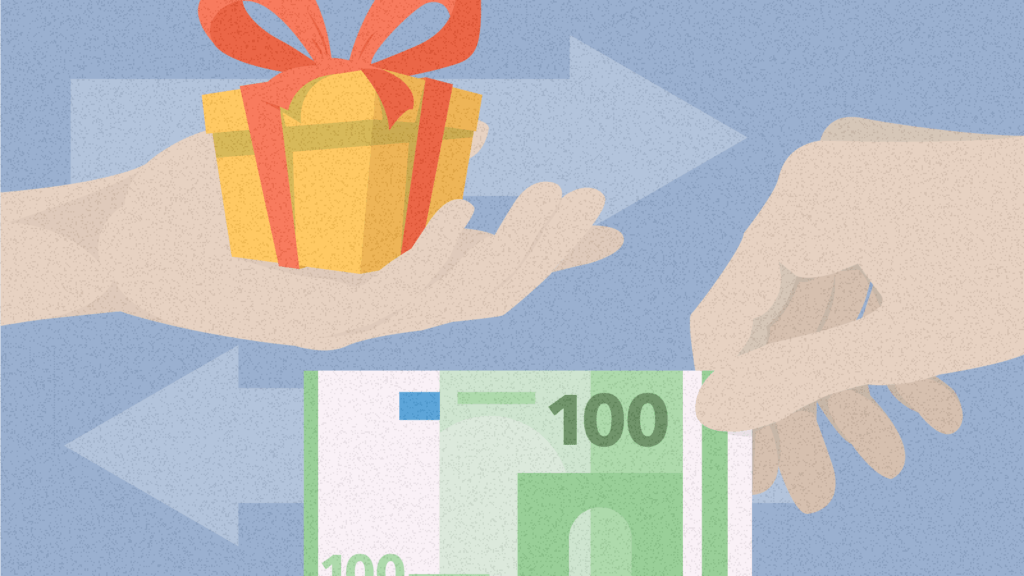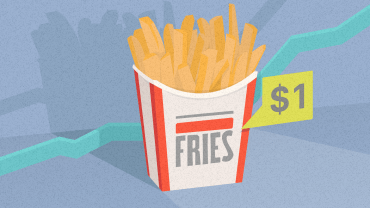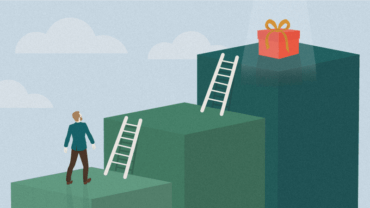Reciprocity – How to Use It to Make Your Customers Buy

When we are given something, we feel like we should return the favor. The interesting part is that just the feeling that we have been given something could be enough to make us buy. Learn how to do this in an original way.
In this article, you’ll discover:
- How just the feeling we have been given something makes us more prone to purchasing;
- How a simple change in wording increased sales of french fries by 54%;
- The right way to give customers something so they will be more likely to buy; and
- How a surprise gift led customers to spend on average 11% more.
Let’s not beat about the bush. Considering you decided to read this article, you are certainly not only interested in behavioral science but also keen to learn how to apply it to your business. But the use of behavioral principles in business is often quite rigid and unoriginal.
Let’s take a look at reciprocity. It’s a behavioral principle that says that if somebody does something for us, we feel the urge to repay them. As research shows, from an evolutionary point of view, it’s a handy behavior that has allowed us to function as a society, and as is often the case with evolution, to reproduce.
Reciprocity
People’s natural tendency to reciprocate if they are given something first. Reciprocity is the strongest when what they receive is unexpected, valuable and personal.
When people from the business environment got to know this, they came up with an approach we often see nowadays – let’s give the customers something for free and they’ll be more likely to accept the offer and make the purchase. That’s why we receive free samples, vouchers, or free trials. But is this how reciprocity should be used in business?
Well, yes. But also – not necessarily. Let’s illustrate with an example.
There was a man named Joe who needed a new pair of jeans. He went to the first store he saw in the mall and after being overwhelmed by a million choices, he finally picked a pair and tried them on. The length was good and the jeans fitted his buttocks well enough to impress Emma, the colleague he had a crush on.
Nevertheless, he didn’t want to buy the first pair he tried, so he decided to take a look in the store across the aisle. “Can I help you?” asked the shop assistant when she saw Joe wandering through the jeans section. “Actually, yes”, replied Joe.

Discover ground-breaking ideas and fascinating solutions.
Before he knew it, the nice lady was assisting him with everything. She told him how the jeans should fit him, how they actually fitted him (including that there were probably better ways to catch Emma’s attention) and brought him all kinds of jeans that might suit him best, including the ones he had tried in the first shop. But this time around, Joe decided to buy them.
Just the feeling that the assistant had spent 30 minutes trying to help Joe pick the best pair of jeans was enough to persuade him to buy.
Why? Because he would feel bad not taking them after the assistant had spent half an hour picking the best pair. As you can see, just the feeling that Joe had been given something (this time, it was the help) was enough to persuade him to buy.
Let’s take a look at what the best ways are to use reciprocity in your business to nudge your customers into a purchase.
Just the feeling we’ve been given something is enough
As seen in the example above, a sense of reciprocity can be created even without you actually giving customers something. But the important part is, the customer has to feel like you did.
Having a hard time grasping that? Let’s take a look at a case study from MINDWORX Behavioral Consulting. Every year there is a charitable campaign in Slovakia called Daffodil Day when thousands of volunteers go out on the streets and help raise money for those suffering from various oncological illnesses.
MINDWORX and a local telco operator teamed up and sent out thousands of text messages persuading people to donate money simply by replying with an empty message.
MINDWORX designed three text messages which they tested against a fourth control message (the same message the NGO had used the previous year) in a randomized controlled trial. One of the three text messages was based on reciprocity and read as follows:
“If you were in need, we would be there to help you. You can help already today by sending an empty text worth 2 EUR to 848. Thank you! League Against Cancer and O2.”
And the results? This message outperformed the original message by 55%. They didn’t give people any gifts, just the feeling of reassurance that they’d be there if needed. They gave their customers a feeling they had received something before they asked anything from them. This brings us to the next point.
Give before you ask
This is an important point. If you want your customers to do something (preferably to buy your product), the customers need to feel they have been given something before you roll out the offer.
This is nicely illustrated by a story the CEO of MINDWORX Matej Sucha likes to tell. A young student, wanted to get into one of MINDWORX’s workshops for free, so he approached Matej with a wonderful email:
“Hi Matej,
Great presentation you gave at TechSummit!
When we met last time, I told you I was applying for an internship at Slido. I started there recently and I spoke about MINDWORX to my colleagues.
We’d like to give you our corporate license for free for a year as sponsorship, and I’ll be happy to give you a short training as well so you get the most out of it.
On Facebook, I noticed your workshop on Behavioral Economics in Marketing. I recently fell in love with the topic and I also got my colleagues hooked.
I’d like to ask if it would be possible for me and 1 or 2 of my colleagues to attend your workshop as part of a barter deal.”
And guess what, he got in for free. But imagine if he had written the email in a different manner – asked to attend the workshop first and then proposed exchange for the Slido license (which MINDWORX didn’t need at all). As Matej says “it definitely wouldn’t have worked.”
If you want your customers to do something (preferably to buy your product), the customers need to feel they have been given something before you roll out the offer.
The order is important. Give first, ask second.
Meet the customer halfway
When it comes to negotiating with your customers, there’s an interesting concept based on reciprocity called reciprocal concession.
If you have ever tried to negotiate in a Marrakesh market, you’ve already experienced it. You see a t-shirt you like and ask how much they want for it. They say 10 €, but there’s no way it’s worth that much so you offer 5 €. In the end, the seller agrees to meet you halfway at 7.
Two things have happened here. First – the seller is satisfied as he probably didn’t expect you to pay the full price anyway. Second – you’re pleased as well, as the seller agreed to lower the price. You perceived his willingness to compromise as very welcoming, which nudged you to make the purchase as well.
When your customers feel like the deal you are offering is very generous, they will feel like they need to return the favor.
Ogilvy used this technique when they were asked by KFC to help boost sales of one-dollar french fries. The catch was that they weren’t able to change the size or even the price of the fries. They could only change how people saw the offer.
So they tested 5 different ways to say one-dollar french fries. One way was based on reciprocity and sounded like this:
“You wanted free french fries, but we’ll meet you halfway with our french fries for $1”
When your customers feel like the deal you are offering is very generous, they will feel like they need to return the favor.
Give your customer something unexpected and personal
Of course, it wouldn’t be right to say that you shouldn’t physically give your customers anything, such as coupons or gifts. When done right, this can also be very effective. But let’s see what doing it right actually involves.
Giving waiters tips is its own thing. It’s the customer’s way to say “thank you for taking care of us”. Basically, it’s reciprocity itself. But how can you increase it even further?
Researchers tried to examine this with a quite simple method – they instructed waiters to offer customers candy at the end of the meal. Not only did they hypothesize that the more chocolates they offered to customers, the bigger the tips they would receive, but they also thought about the manner in which the candy was offered.
In the control condition, the waiter didn’t offer customers any candy. In the first experimental condition, the waiter would offer a piece of chocolate when delivering the bill, which increased the average tip size by 3.3%. When that one piece of chocolate was replaced with two, the tips increased by 14.1%.
In the third condition, they tried something different. The waiter gave the customers two pieces of candy as well, but the manner in which it was delivered was changed. First, the guests were offered a single piece. But as the waiter was walking away from the table, he stopped, turned back, and gave the guest another chocolate. The mean tip in this condition increased by 21%.
Why were the results different even though the customers received two candies in both the second and third experimental conditions? They felt obligated to give something back as it felt like the waiter had given them extra candy, but also because it was unexpected and personal.
Making it personal also proved to be effective for the Behavioural Insights Team who tested the effectiveness of SMS when encouraging job seekers to attend job fairs. The SMS prompts were very simple and worked by informing people when job opportunities arose.
They found that an SMS that drew on reciprocity was the most effective. It worked by informing job seekers that the job advisor had done something specifically for them (he had booked them an appointment) and wished them luck. This SMS led to a 26.8% increase in attendance.
When customers don’t see it coming, it feels like a nice gesture. In another case study, customers were given surprise coupons when entering a shop. As it turned out, they ended up spending 11% more on average compared to those who had received the coupons in advance.
Giving away free stuff is nothing new and customers may perceive it as a standard marketing move. That’s because it is. So when you do it, make sure it departs from what’s expected and make sure it feels like a nice gesture. When you give a discount or free gifts, personalize them and make the customer feel like they deserved it.
Reciprocity is a powerful principle which, when used the right way, can play an important role in your sales. If you want to learn more about it, check out our Reciprocity ebook.
Key takeaways:
- You don’t necessarily need to give customers something. Just the feeling that they have can make a difference. Let them know you are there for them and willing to help them if needed.
- Give first, ask later. For customers to act, they need to feel that they have received something from you first.
- Make your customers feel like the deal is a compromise. They will feel more obliged when they see your goodwill.
- Surprise your customers with something unexpected and personal. A personalized gift is more valuable than a general one. And when customers don’t see it coming, it will look like a nice gesture.





